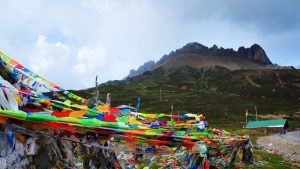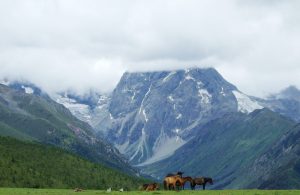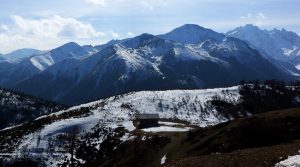
Baimang Snow Mountain in Diqing
Attraction Overview
Baima Snow Mountain National Nature Reserve is located at the south-eastern part of Deqin County of Diqing Tibetan autonomous prefecture, northwest of Yunnan province. It's high in the north and low in the south, in the transitional zone between Qinghai-Tibet plateau and Yunnan-Guizhou plateau. It is the largest national nature reserve for protecting Yunnan golden monkey in China. The main objects of protection are alpine coniferous forest, mountain vertical vegetation landscape and Yunnan golden monkey.
Attraction Type: Nature Reserve
Chinese Name: 白马雪山自然保护区(Pinyin: Baima Xueshan Ziran Baohuqu)
Best Time to Visit: Summer and Autumn
Recommended Visiting Time: Half Day
Open Hours: All Day Long
Admission Fee: Free
Highest Altitude: 5,430 m
Location: at the south-eastern part of Deqin County of Yunnan province
Why is Baima Snow Mountain So Special?
Covering an area of 190,000 hectares, Baima Snow Mountain National Nature Reserve has a complete vertical sight of virgin forest and rare plants and animals. There are 20 peaks of more than 5.000 meters above sea level, among which the highest is Baima Snow Mountain covered with snow all year round, with the altitude of 5,430 meters. It aims to protect the rare black snub-nosed monkeys, and natural views of the typical mountainous vertical zone (high mountains and canyons) of the Hengduan Mountain Range.
Where is Baima Snow Mountain – Location
Situated on the central part of the Hengduan Mountains, Baima Snow Mountain Nature Reserve stands on the slope of the section between the Baima Snow Mountain, the major peak in the north of the Yunling Ranges and Renzhi Snow Mountain. It is between Deqin County of the Diqing Tibetan Autonomous Prefecture and Markam County in the Tibet Autonomous Region. It’s high in the north and low in the south, in the transitional zone between Qinghai-Tibet plateau and Yunnan-Guizhou plateau.
Culture and History
Baima Snow Mountain Nature Reserve was established by the people’s government of Yunnan province in 1983, and was promoted to national level in 1988. Approved by the general office of the state council in 2000, the expanded reserve covers nine townships (towns) in Deqin and Weixi counties in the Tibetan autonomous prefecture of Diqing. It is recognized as a “Kingdom of Animals and Plants in a Cold Temperate Mountain” for its rich animal and plant resources. Overlooking the snow-capped main peak, it is just like a white horse running through the mountains, hence the name “white horse snow mountain”.

Natural Resources
Plants:
The nature reserve has the distinct features of a three-dimensional appeal of climate and vegetation. Inside the nature reserve, there is a vast area of virgin forest including 13 species of national key protected wild plants such as Circaeaster agrestis and Pseudotsuga forrestii Craib. Highland oak birch, Yunnan pine, George’s fir, snow-white rhododendron, and vitchleaf sophora are the main plants in the reserve.
Animals:
The dense mountain forest of Baima Snow Mountain provides the best place for wild animals to live, especially the wild species of usual mammals(47 species) and birds(45 species), and some animals peculiar to the Hengduan Mountains. Such as lesser panda and green-tailed monal. As well as other rare wild animals at higher altitudes, such as snow leopard, white – eared pheasant, horse musk deer.etc. The most famous is the snub-nosed monkey or the Yunnan golden monkey, which lives in the sub-high mountain dark pine coniferous tree forests.
How to Get There?

By Bus:
Shangrila – Deqin: Four buses leave from Shangrila Bus Station to Deqin County every morning at 7:20 am, 8:20 am, 9:20 am and 12:00 pm, which takes around 5-6 hours. The last return bus to Shangri-La from Deqin County is at 3:00 pm.
Deqin – Baima Snow Mountain: The buses running to Benzilan will go through the Baima Snow Mountain Pass. Tourists can take off here.
By Car-rental:
From Shangri-la or Deqin county, tourists can go to Baima Snow Mountain Pass or Baima Snow Mountain Observation Deck by car-rental. Yunnan Exploration Travel can tailor-make a tour for you to visit the Baima Snow Mountain. Our private car and guide will ensure you have a comfortable trip.
What to See at Baima Snow Mountain?

Baima Snow Mountain Nature Reserve has fantastic landscapes. Tourists can enjoy the landscape of the snow-covered area in the winter and the splendid sceneries of snow and ice melting, lofty peaks and flowing water in the summer. In the autumn, the snow mountain looks extremely high under the clear sky of autumn. As a “Kingdom of Animals and Plants in a Cold Temperate Mountain”, tourists can also have a chance to see the rare animals and plants.
Best Time to Go
The best seasons to enjoy the scenery of Baima Snow Mountain are summer and autumn from July to October. At this time, the ice along the highway are melted, and streams are babbling everywhere. The azalea like a blazing fire, birds singing in the forest, and monkeys playing all makes people fascinated. The mountain is closed from December to April because of the heavy snow and icy road.
Attractions Nearby
Dongzhulin Monastery is the largest one of the three Gelu Sect monasteries in Deqin County and one of the religious cultural activity centers in Kangnan District. The housed treasures include gilded Maitreya , statue of White Drolma, Buddhas of Three Worlds, the ruler of the hell, Manjusri, 18 Arhats statues and Tangkar scroll paintings depicting Buddhist stories. There are also a great number of Buddhist stupas and religious instruments and props, being a Buddhist cultural treasure house for the pilgrims.
The Moon-shaped Bend of Jinsha River
Also called the Great Bend of Jinsha River, the bend is 15 km north of Benzilan Township of Deqin County. Jinsha River, the upper reach of the Yangtze River, is blocked by mountains on its way southward, and a hairpin turn has thus been formed as a natural wonder.
Meili Snow Mountain is one of the most sacred mountains of Tibetan Buddhism. In the 1930s, they were praised by American scholars as the most beautiful mountains in the world. Meili Snow Mountain boasts numerous snow-clad ridges and peaks, thirteen of which are more than 6,000 meters above the sea level. The highest peak Kawagebo, which rises to 6,740 metres, has never been summited.
Feilai temple, the best place to watch goden peaks of Meili mountain at sunrise. So if u plan to watch sunrise, it’s absolutely a good idea to live at Feilai temple the night before. But actually it is unusual to see the goden peaks. The peaks of the mountains are often surrounded with clouds due to the high altitude they are. And this makes more interestings for Meili. There’s a kind of saying that, if any Japanese appears in this area then people can’t see the golden peaks that day. This is because Japanese are not welcomed by Tibetan people. Yes, they hate Japan and Japanese, just like people in notheast of China.
Useful Travel Tips
► Baima Snow Mountain Nature Reserve has the most beautiful mountain azalea forest in China, and the refreshing azalea is in full bloom in spring and summer.
► There are beautiful colorful trees in the forest area during autumn and winter which are worthing visiting.
► One can only enter the mountain area on foot after getting the approval by the protection bureau.
► Crossing over the Baima Snow Mountain Nature Reserve needs to climbing two passes(Lalaka Pass and Baima Pass). With high altitude and strong wind, it is necessary to keep warm and prevent altitude sickness.
Tours including Baima Snow Mountain
2 Days Kawa Karpo Meili Snow Mountain Tour from Shangri-La
5 Days Shangrila Discovery with Meili Snow Mountain Pilgrimage
7 Days Baimang Snow Mountain Hiking Tour to Nine Lakes and One Mountain Scenic Area
7 Days Shangrila Meili Snow Mountain and Yubeng Village Trekking Tour
11 Days Yunnan Classic Tour with Meili Snow Mountain Pilgrimage












